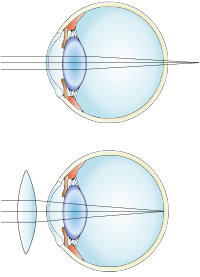
Photo from wikipedia
This study aimed to examine the effectiveness of photorefractive keratectomy (PRK) in treating patients with cycloplegic hyperopia from +1.00 to +7.00 diopter using Allegretto wave Eye Q 400. This study… Click to show full abstract
This study aimed to examine the effectiveness of photorefractive keratectomy (PRK) in treating patients with cycloplegic hyperopia from +1.00 to +7.00 diopter using Allegretto wave Eye Q 400. This study was conducted on 25 patients with cycloplegic astigmatism ≤1 diopter and cycloplegic hyperopia between +1.00 and +7.00 diopters in 47 eyes, who successively entered into the study within 6 months and underwent PRK. Prior to PRK surgery, all the patients were examined for cycloplegic refraction (astigmatism and hyperopia), slit lamp, keratometry, fundus, and best-corrected (BCVA) and uncorrected visual acuity (UCVA) testing. These examinations were repeated after 1 week, 1 month, 3 months, 6 months, and 1 year postoperatively. The mean preop UCVA of patients was 0.76±0.28 (ranging from 0.00 to 1.3), which reached 0.19±0.22 (ranging from 0.00 to 0.78) one year after the surgery (P=0.000). There was a significant correlation between increasing astigmatism and preop cycloplegic hyperopia >5 diopters (P=0.000), corneal ring haziness at 12th months (P=0.000), and 12 months cycloplegic residual hyperopia ≥2.00 diopters (P=0.000). 53.2% of the eyes (with a mean grade of 2.34) were detected with corneal ring haziness at 12th months, which was significantly correlated with 12 months residual cycloplegic hyperopia of ≥2.00 diopters (P: 0.000) and cycloplegic sphere above 5 diopters (P=0.006). Although the use of photorefractive keratectomy (PRK) with Allegretto Eye Q 400 is associated with a decrease in the mean cycloplegic and improved UCVA and BCVA, its use is not recommended in cases with preop cycloplegic hyperopia above 5 diopters due to the high rate of induction of astigmatism, corneal haziness, and regression of hyperopia.
Journal Title: Journal of Medicine and Life
Year Published: 2022
Link to full text (if available)
Share on Social Media: Sign Up to like & get
recommendations!